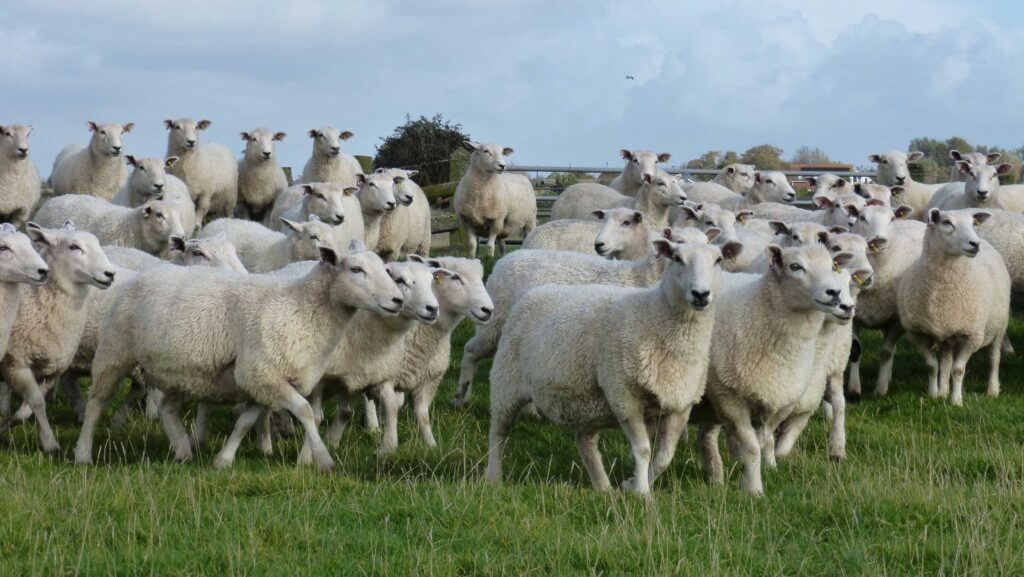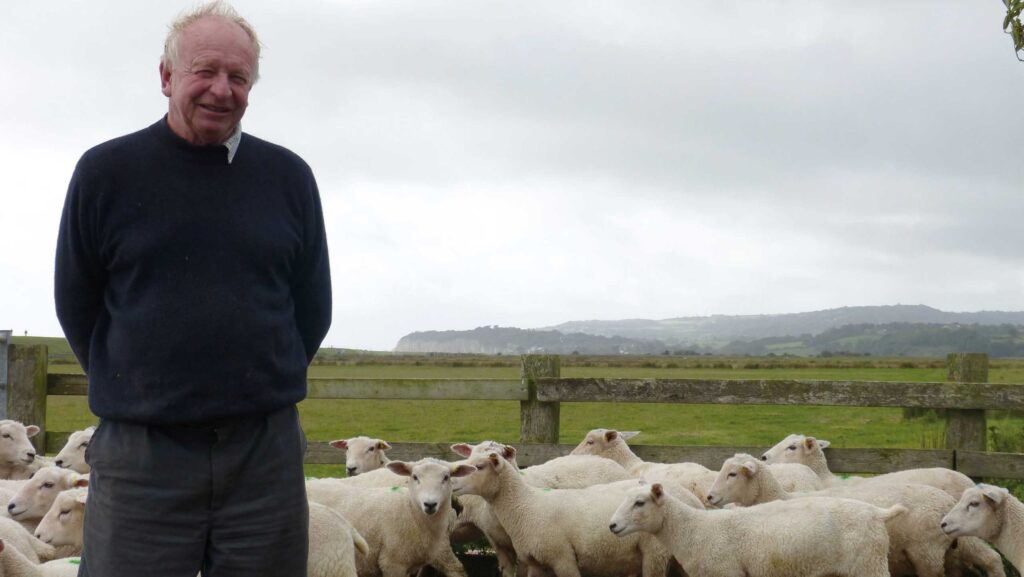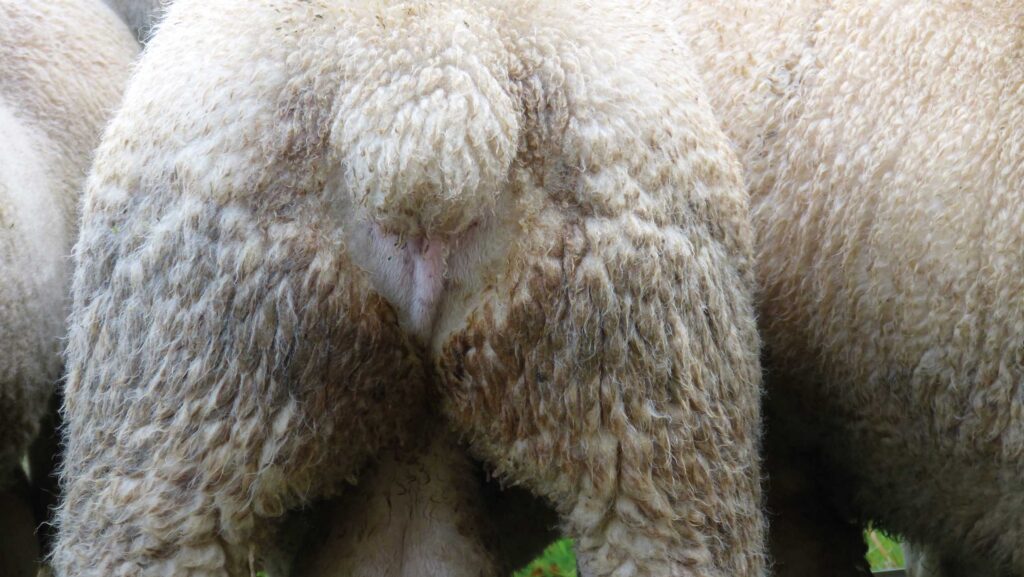Farmer imports breed to lift wool cheque up to five-fold
 © Michael Priestley
© Michael Priestley A large-scale, low-input Romney breeder has added low-micron fleece to his breeding goals, with the aim of turning a loss-making wool enterprise into a profitable one.
Frank Langrish, of Langrish Farmers at Ludley Farm, near Rye, on the Sussex/Kent border, has a two-pronged approach to improving wool quality in his 4,000-ewe operation.
See also: Shed v shear – tackling the wool price challenge
Firstly, he is selecting for Romneys capable of producing sub-30-micron wool.
Secondly, he has imported soft-wooled Snowline rams from New Zealand to produce wool closer to 25 micron (see “Micron matters”) from Romney crosses he is grading up into Snowlines.
After trying the shedding route, Frank found the wooliness of the Romney meant it took too long to see results.
He adds: “Meat production is still the priority, and that’s what the business is based on, but I am adding another point of selection.
“Half our income came from wool in the 1960s, so I’m keen to find a way to improve its value.”
His flock’s wool quality is being measured at the Wool Testing Authority Europe, Caernarfon, in a 12-month Defra-funded (Innovate UK) sheep breeding project called Fabulous Fibre.
These results will feed into Frank’s breeding decisions.
Farm Facts

Frank Langrish © MAG/Michael Priestley
- Farming 950ha in total
- Farming company rents the family farm on farm business tenancies
- 4,000 Romney ewes, summered on 283ha of Romney Marsh
- Producing 2,000 prime lambs, 2,000 store lambs and keeping 1,500 as replacements, with surplus females and rams sold for breeding
- Averaging 1.4-1.5 lambs a ewe, sold or retained
- Supplying 10-25 lambs a week to butchers 48 weeks of the year
- 55 pedigree Sussex suckler cows
- Supplies beef to local butchers from June to December
Micron matters
Wool fibre diameter is measured in microns (1 micron = 1/1,000mm). This measurement is a major determinant in the value of wool.
A micron of less than 30 is not rough to the skin, making it useful in clothing. More than 30 and the value and application of the wool diminishes, often competing with synthetic materials in the carpet market.
More than 90% of the wool handled by British Wool measures 30 micron or higher:
- Fine wool Produced by Charollais, Down breeds, Suffolk, Blue Faced Leicester (26-35 micron)
- Medium wool From Beltex, Texel, Romney, Lleyn, Scotch and Welsh halfbreds and Border Leicester (31-40 micron)
- Cross Mules, Masham, Scottish Greyface and so on produce coarser wool (35-45 micron)
- Lustre breeds Wensleydale, Teeswater, Longwool breeds (32-42 micron)
- Hill Cheviot, Shetland, speckled face breeds, Exmoor Horn, Lonk and so on (35-plus micron)
- Mountain Blackface, Rough Fell, Swaledale (35-plus micron)
- Heritability Wool fibre diameter is strongly genetically heritable – 61% in Romneys in the Fabulous Fibre trial
Inspiration
Two things happened during the Covid pandemic that led Frank to the Snowline breed.
Demand for wool for carpet manufacturing crashed, and he got just £5,000 for the wool from all his sheep, ewe lambs, shearlings and 80 tups. The shearing bill cost him £16,000.
Then, in January 2021, Frank watched Kiwi shearer Megan Whitehead shear 667 strong-wooled lambs in nine hours, setting a new world record.
“I marvelled at the fantastic fleece the lambs had, and they turned out to be Snowlines,” he says.

© MAG/Michael Priestley
Importation
Keen to learn more about the breed, Frank contacted the McDonald family – the Snowline breeders – on the South Island of New Zealand.
He arranged a visit in person to see their sheep and was satisfied they would work back home.
Snowlines are “nil-shepherded” on high-country sheep stations on grass and forage. They are bred for short, clean tails to eliminate the need for docking and crutching.
This suits Frank’s system, which lambs 4,000 Romney ewes outdoors on the Romney Marsh from mid-March.
Neither ewes nor lambs receive concentrate feed (no out-of-bag feeding since 1963) and graze at a stocking rate of 14 ewes a ha plus lambs until they are trucked to winter keep across southern England.
Frank also researched the Olann breed from the Kelso company, also in New Zealand, but opted for the Snowline.
As a fixed breed, this would be more consistent than a composite, he says. Last autumn, he imported 14 Snowline ram lambs with an average wool micron of 26.5 and bought the rights to use the Snowline name in the UK.
First cross
The rams sired 350 ewe and ram lambs, which were all recorded at birth. The best ewe lambs will be tupped this autumn to an unrelated Snowline ram.
The best ram lambs have mostly been sold to other interested breeders. Wool measurements for the lambs are all under 28 micron.
“We expected a 40% improvement in wool fibre diameter but achieved 60%,” says Frank, a former British Wool chairman.
“On the back of these results, I have reduced my selection level from 30 to 28 micron.”
Breeding plan
He plans to split the flock the following ways:
- Pure Romney Keep about 1,000 pure Romneys to breed for lower micron wool. Frank’s Romney wool is typically 32-36 micron, but testing on the farm has shown several lines under 30 micron.
- Snowline Nucleus Grade up a flock of 1,500 Snowline ewes. Genetic gain and selection pressure are being achieved by working with five other flocks in the UK – including Innovis – to produce more Snowline F1s.
- B flock Produce a commercial flock of about 1,500-head from Snowlines and Romneys that fail to make stud grade but are still good-quality, functional sheep. These will be crossed to Innovis sires to produce prime lambs and ewe lambs for sale for breeding.
With Frank’s knowledge of the wool trade, he is optimistic that purebred Snowline rams and low-micron Romneys will appeal to commercial flocks running low-input systems who are looking to increase the value of their wool cheque.
Wool sales
Frank says progress will be steady, it being a genetic endeavour. “One sale lot of wool is 8t, and three sale lots are needed for a container-full. It is going to take us up to five years to produce one sale lot.”
A major help would be a review of British Wool’s payment system (see “Snowline wool should be worth five times more”), from grading wools on breed alone, to recognising and rewarding micron size.
“A sea change is needed, really,” says Frank. “Measuring and rewarding micron will incentivise finer wool across the industry.”
Snowline wool should be worth five times more
Richard Alderson, head of wool sales at British Wool, told Farmers Weekly:
- One spinner said British wool available at 27-28 micron would be a “game changer”
- Snowline wool’s value is unknown as it will be 18 months or more before commercial volumes are available to sell
- British-produced Snowline wool at 27-28 micron should sell for about five times the price of wool at 30-34 micron
- If 10-15% of 30–34-micron British wool moved into a higher quality bracket, this would spread overall production more evenly across a wider micron range, potentially levelling out supply imbalances and benefiting all wool producers.
